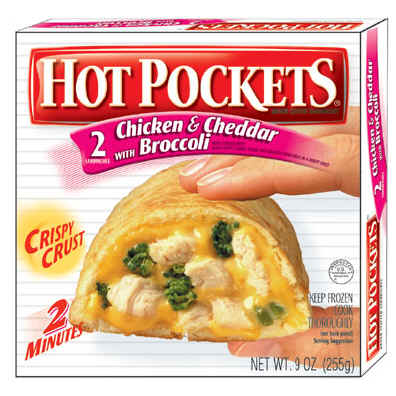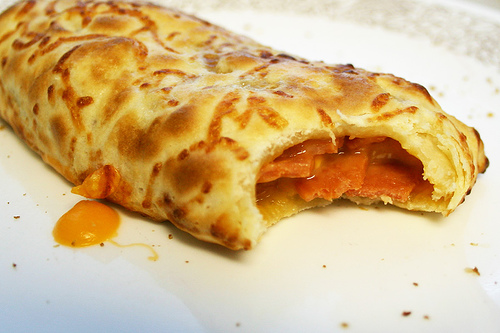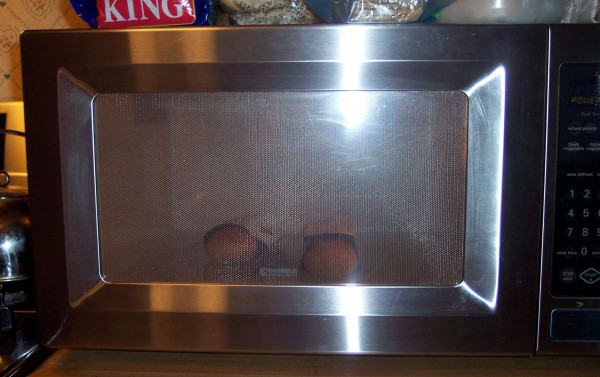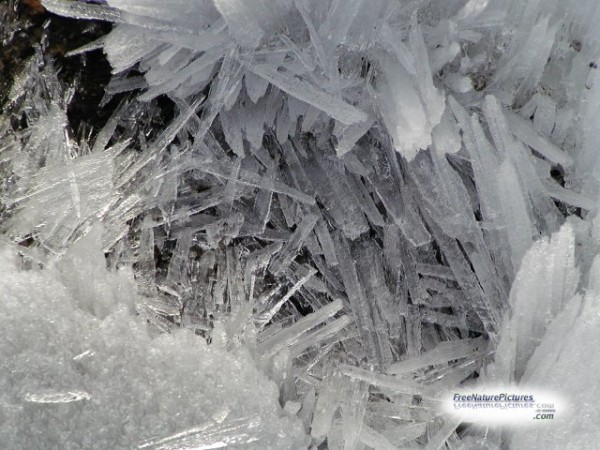When I was a teenager, my choice of food was basically determined by three criteria:
- It needed to be ready in under 10 minutes.
- It needed to have enough calories to make me not hungry anymore.
- And it needed to be (marginally) edible.
That was really it. And so it won't surprise you to know that a portion of my diet at the time consisted of -- you guessed it -- Hot Pockets. And to be fair, they don't actually look so bad on the box.

For those of you who don't know, a Hot Pocket is a frozen Pop-tart filled -- instead of with fruit -- with nasty meat and sauce. You're supposed to stick it in a microwave for a few minutes and let it cook/heat, and then it's supposedly edible. But it never actually is. They always come out looking like this:

They've even had to redo their entire advertising campaign, after a (really funny) comedian so eloquently explained the entire problem with Hot Pockets.
"Is your Hot Pocket cold in the middle?"
"It's frozen. But it can be served boiling lava hot."
"Will it burn my mouth?"
"It'll destroy your mouth. Everything will taste like rubber for a month."
This is a problem -- not just with Hot Pockets -- but with many microwaveable frozen things. Either you can heat the outside to a normal temperature and the inside will be frozen, or you can heat the inside to a normal temperature, which requires the outsides to boil. Either way, you lose.

But why? What's the physics behind this? Microwaves are just a type of electromagnetic radiation, like visible light, infrared radiation (commonly called heat), and radio waves. But microwaves are special because they are just the right wavelength to be absorbed by fats, sugars, and water. The water -- in particular -- does something special. Water molecules are very simple, with an electronegative oxygen atom and two electropositive hydrogen atoms.

You bombard these molecules with microwaves, and the microwaves cause the water molecules to rotate.

Rotational motion is a form of energy, and that excess energy causes the water to heat up! But there's a difficulty for your frozen Hot Pockets. You see, the water molecules aren't free to move.

They're bound in crystals! On a molecular level, they bind together like this:

Which means that microwaves don't heat ice, not nearly as efficiently as they heat water! (Thanks to Michael Broide for showing me about this phenomenon.) The outermost layer of your frozen food has just been exposed to air, so some of those crystals have started to melt. That outer, watery layer can heat up quickly. But all the layers inside are lousy at absorbing microwaves!
So the outer layer has to get hot enough to melt the ice crystals in the next layer. Then that newly-melted water can heat up and melt the ice farther in. In the meantime, however, the outermost layer gets really hot! And that is why Hot Pockets can both destroy your mouth and be frozen on the inside at the same time!
Haaaaahhhh-ot Pockets!
- Log in to post comments

Microwaves are awesome. (And so are hot pockets.)
Anyone else tried measuring the speed of light with marshmallows in a microwave oven? (Amazingly, that demo actually works, too, if you're careful...)
I've never had any desire to eat a hot pocket. I also never go to McDonald's or other fast food burger places. I do occasionally go to Dunkin' Donuts or sub shops though (Quiznos, Subway). More than half the time I eat fish (sushi or cooked).
I use the microwave for heating up leftovers or baking potatoes, never freezer food.
A post on the physics of microwaving Hot Pockets and no explanation of how the crisping sleeve works?
I needed a good laugh before sleep.
What's this about measuring the speed of light with marshmallows in a microwave? Googles. Stay Puft Marshmallow Man explosions, here I come.
Doh! Explosions reduce my ability to take accurate measurements.
I wouldn't eat a Hot Pocket if you paid me, but I did learn something new today.
Dude, your blog rocks! Keep up the great work!
I think i see jesus in that picture of your hot pocket! Just kidding. Or... no that's Darwinius.
Great post!
A question, then: What would the "defrost" setting be doing, then? As I use my microwave, "defrost" is for when I don't want to cook any part of the food item, but just thaw it, and it does that fairly well, too.
So, microwaves can heat up a cup of sugar or a cup of lipids?
Just a question. I've heard many critics about eating microwaved food. They claimed that the microwave still stays in the food and when you eat the microwaved food, you eat the microwave, which is unhealthy.
Being a science student, I know that microwave just cause the water molecules to rotate. That doesn't sound unhealthy to me.
Hence my question, Is eating microwaved food as healthy as eating the usual cooked food?
Ha! Cool post. I'm with Brian, no nasty hot pockets for me.
Sophos, "microwave still stays in the food" is utter nonsense. Microwave energy is not ionizing radiation (think uranium and Geiger counters) so it can't "stay in the food" any more than shining a flashlight at a pizza traps the light in it.
Now there is the question of the microwaves altering the chemical make up. For example (from Wikipedia on "microwave oven"), 30-40% of the active form of vitamin B12 is converted into an unusable form.
One method that I've found somewhat successful in mitigating the mouth-annihilating properties of hot pockets and microwave burritos (another terrible offender in this area) is to run the microwave in shorter bursts.
This allows available liquid water molecules to start spinning their little hearts out enough to acquire some heat, then the brief pause allows the heat to radiate a bit and work its magic on still-frozen neighbors. After a few seconds, the amount of liquid water available for microwave heating increases quite a bit and re-initiating the cooking process is much more effective.
Rinse and repeat.
What's next, Ethan? Explaining why adding salt to your pasta's cooking water is a good idea? :)
@Andrew: If I recall correctly, defrost settings just modulate the microwave emitter to essentially do the process I described above (zap it, wait, zap it, wait, etc.) to avoid applying excess heat -- the amount of energy that would start burning a substance -- while working to liquify as much of its water as possible.
Based on my experimenting with a 2.4GHz spectrum analyzer and the little I know of EE...
For most microwaves (that is: the five I tested), the "defrost" is merely a pre-set power setting around 2-4. In turn, the power settings from 1-10 correspond to how many microwave bursts are emitted from the magnetron each second; power 1 is one burst, power 5 is five bursts, power 10 is 10 bursts. Typical 1000 Watt microwave implies the burst is 100 Joules per; multiply or divide as needed for your toy.
Lower settings give the energy more time to diffuse evenly in the food, from the parts directly heated to those heated by thermal conduction from the rest.
So, the sensible solution would be to cook the Hot Pocket at a lower setting for longer, letting the same amount of energy diffuse better. However, that takes longer, and most college students don't care that much; they're HUNGRY NOW.
Being gluten-intolerant and even less patient, my instant food of choice is a can of Chunky's Chicken and Sausage Gumbo. More flavor than most cheapish soups, no water to add, still edible at room temperature, pop-top can. Get can, get spoon, open, eat. (Disadvantage: not handheld, so can't be eaten en-route.)
The problem with hot pockets is more what happens after you eat them.
Thank Colin for your reply. So microwave doesn't "stay" in the food. Rather it alters the chemical structure? that it makes 30-40% vitamin B12 unusable. But is that dangerous if consumed?
hot pockets are far, far better when put in the oven. Then they cook evenly and the pocket part actually gets crispy instead of it all turning into a mushy mess.
I went through a 3-week period where I ate nothing but pizza-flavored hotpockets and, oddly enough, watermelon. During that time, I thought the hotpockets were the bees knees + bought enough to fill the freezer with. The taste for them didn't last, so I had to figure out the best way to be able to stand them.
Here's what I have learned, for anyone out there who may be struggling with a freezer full of hotpockets:
they are the perfect hangover food. they also taste pretty damn good when you're coming off stimulants. On opiates, they are tolerable. However, if you not either on something or withdrawing from something, there is nothing to do but accept that they are inedible and view eating them as a gladiator exercise.
Ethan,
(great post!)
My brother's father-in-law invented a Teflon like compound while working at Kraft back in the early 80's that was to be sold by Tupperware to brown hamburgers in microwave ovens.
Care to guess why it never reached market?
Sophos: As far as I now, the most significant with the heating food in microwave ovens is that it encourages us to buy and use more already prepared and packaged food than to cook by ourselves (which is, of course, much more healthy and tasty ;) ).
Probably some stupid journalist just heard about non-healthy microwave food and made up "staying microwaves" story.
It's probably worth mentioning that Vitamin B destruction occurs because of the heat - not any inherent property in microwaves that differ from using a conventional stove or oven.
If you cook your food you destroy a lot of it's nutrient content (if you don't cook your food you risk bacterial poisononing, plus it tastes bad).
I agree with Rafal. The major health effect of microwaves is encouraging consumption of pre-processed foods. However, whether these foods are actually less healthy or not really depends on the food, how much you eat, and what you eat it with.
Ethan, great post. you are now officially my most favorite SciBlogger.
My hot pockets are usually nice and warm on the outside, and UNBEARABLY HOT on the INSIDE.
Idiot.
for cooking them in the oven try them on 450 middle of the oven... for about 10-12 mins depending on your oven and your elevation...
hope some one reads this...
the best thing to do is stick a copper wire inside(leaving it visible outside as well) heat it from outside till the ice melts....then microwave! XD
I get how the hot poket thing works, but what about the middle of a toaster stroodle that's cold in the middle after comming out of the toaster?
Ethan, I have stopped using my microwave after a very famous food scientist revealed the information on how the machine influences- read changes the chemical structure of your food, and what it does to water. Well, the results are just dramatic.
thanks for your info, it was fun to read
hehe, hey Sir
while I was laughing while reading it, I starting really smiling while going through the comments. Much fun, especially the comment done by the person describing himself as an idiot.
I like your blog Ethan
what would happen if you ate a thawed uncooked hotpocket?
I just saw this today but have always heard of and wondered about the chemical composition of the crisping sleeve and how it works, e.g. changes the B12 into an unusable form.
I went to the grocery store and bought hot stuffs I left it in my kitchen when I got home I forgot I had frozen stuffs I was gone about an hour I came back home and they were almost all thawed I put them back in the freezer. Am I safe to eat them now
I love how bitchy some of you are, "i would never ever ever eat a nasty gross microwavable thing like a hot pocket, just fish and sushi and kale and bladdee bladdee bla" get with the program, remove the stick from your anus and microwave some eggrolls :) intriguing article though, i had never considered that the reason my food was still a chunk of ice was because the microwaves had not penetrated that deep into my oh so delicious all artificial burrito :)
bump! ?